Frictional Behaviour of Composite Anodized Layers on Aluminium Alloys
Abstract
:1. Introduction
2. Materials and Methods
2.1. Sample Preparation
- (1)
- oxidized to a case depth of 10 µm,
- (2)
- oxidized to a case depth of 10 µm in a bath with 2 wt.% of SiC admixture,
- (3)
- oxidized to a case depth of 10 µm in a bath with 2 wt.% of Si3N4 admixture.
2.2. Mechanical Properties
2.3. Phase Composition Analysis of the Anodized Surface
2.4. Tribological Properties
3. Results and Discussion
3.1. Mechanical Properties Results
3.2. Phase Composition Results
3.3. Tribological Properties Results
4. Conclusions
Author Contributions
Funding
Conflicts of Interest
References
- Davis, J.R.; Associates, J.R.D.; Committee, A.S.M.I.H. Aluminum and Aluminum Alloys; ASM specialty handbook; ASM International: Cleveland, OH, USA, 1993; ISBN 9780871704962. [Google Scholar]
- Ch, S.R.; Raja, A.; Nadig, P.; Jayaganthan, R.; Vasa, N.J. Influence of working environment and built orientation on the tensile properties of selective laser melted AlSi10Mg alloy. Mater. Sci. Eng. A 2019. [Google Scholar] [CrossRef]
- Zhang, L.; Zhang, S.; Zhu, H.; Wang, G.; Zeng, X. Investigation on the angular accuracy of selective laser melting. Int. J. Adv. Manuf. Technol. 2019. [Google Scholar] [CrossRef]
- Mueller, M.; Riede, M.; Eberle, S.; Reutlinger, A.; Brandão, A.D.; Pambaguian, L.; Seidel, A.; López, E.; Brueckner, F.; Beyer, E.; et al. Microstructural, mechanical, and thermo-physical characterization of hypereutectic AlSi40 fabricated by selective laser melting. J. Laser Appl. 2019. [Google Scholar] [CrossRef]
- Rao, H.; Giet, S.; Yang, K.; Wu, X.; Davies, C.H.J. The influence of processing parameters on aluminium alloy A357 manufactured by Selective Laser Melting. Mater. Des. 2016. [Google Scholar] [CrossRef]
- Montoya, Z.R.D.; Vera, L.E.; Pineda, T.Y.; Cedeño, M.L. Effect of the layer of anodized 7075-T6 aluminium corrosion properties. J. Phys. Conf. Ser. 2017, 786, 12032. [Google Scholar] [CrossRef]
- Zhou, L.; Yu, M.; Liu, B.; Zhang, Z.; Liu, S.; Song, X.; Zhao, H. Microstructure and mechanical properties of Al/steel dissimilar welds fabricated by friction surfacing assisted friction stir lap welding. J. Mater. Res. Technol. 2020, 9, 212–221. [Google Scholar] [CrossRef]
- Zhang, C.Q.; Liu, W. Abnormal effect of temperature on intermetallic compound layer growth at aluminum-titanium interface: The role of grain boundary diffusion. Mater. Lett. 2019, 254, 1–4. [Google Scholar] [CrossRef]
- Pietrzyk, B.; Miszczak, S.; Szymanowski, H.; Sobczyk-Guzenda, A.; Gawronski, Z. Plasma enhanced aerosol–gel method: A new way of preparing ceramic coatings. J. Sol Gel Sci. Technol. 2013, 68, 455–463. [Google Scholar] [CrossRef] [Green Version]
- Pietrzyk, B.; Miszczak, S.; Kaczmarek, Ł.; Klich, M. Low friction nanocomposite aluminum oxide/MoS2 coatings prepared by sol-gel method. Ceram. Int. 2018, 44, 8534–8539. [Google Scholar] [CrossRef]
- Curran, J.A.; Clyne, T.W. Thermo-physical properties of plasma electrolytic oxide coatings on aluminium. Surf. Coat. Technol. 2005, 199, 168–176. [Google Scholar] [CrossRef]
- Ibrahim, H.; Esfahani, S.N.; Poorganji, B.; Dean, D.; Elahinia, M. Resorbable bone fixation alloys, forming, and post-fabrication treatments. Mater. Sci. Eng. C 2017, 70, 870–888. [Google Scholar] [CrossRef] [PubMed] [Green Version]
- Dunleavy, C.S.; Golosnoy, I.O.; Curran, J.A.; Clyne, T.W. Characterisation of discharge events during plasma electrolytic oxidation. Surf. Coat. Technol. 2009, 203, 3410–3419. [Google Scholar] [CrossRef] [Green Version]
- Snizhko, L.O.; Yerokhin, A.L.; Pilkington, A.; Gurevina, N.L.; Misnyankin, D.O.; Leyland, A.; Matthews, A. Anodic processes in plasma electrolytic oxidation of aluminium in alkaline solutions. Electrochim. Acta 2004. [Google Scholar] [CrossRef]
- Moon, S.; Jeong, Y. Generation mechanism of microdischarges during plasma electrolytic oxidation of Al in aqueous solutions. Corros. Sci. 2009. [Google Scholar] [CrossRef]
- Matijošius, T.; Ručinskienė, A.; Selskis, A.; Stalnionis, G.; Leinartas, K.; Asadauskas, S.J. Friction reduction by nanothin titanium layers on anodized alumina. Surf. Coat. Technol. 2016, 307, 610–621. [Google Scholar] [CrossRef]
- Canyook, R.; Seubsom, P.; Sang-ngean, J.; Trirujirapapong, T.; Taweesup, K. Influences of sealing solutions on anodized layer properties of 7075 aluminium alloy. Mater. Today Proc. 2018, 5, 9483–9488. [Google Scholar] [CrossRef]
- Jabbari, R.; Mirjani, M.; Rezagholi, H. Study on mechanical properties of anodised film containing nano-diamond particles. Trans. IMF 2016, 94, 166–170. [Google Scholar] [CrossRef]
- MatWeb Material Property Data Aluminum 2017A Composition Spec. Available online: http://www.matweb.com/search/DataSheet.aspx?MatGUID=236edd2c6b2e4b02a8b902797094ef7f&ckck=1 (accessed on 18 March 2020).
- Aircraft Materials UK Aluminium Alloy 2017A Technical Data Sheet. Available online: https://www.aircraftmaterials.com/data/aluminium/2017a.html (accessed on 18 March 2020).
- Lu, J.; Wei, G.; Yu, Y.; Guo, C.; Jiang, L. Aluminum alloy AA2024 anodized from the mixed acid system with enhanced mechanical properties. Surf. Interfaces 2018. [Google Scholar] [CrossRef]
- Kamali, A.R.; Feighan, J.; Fray, D.J. Towards large scale preparation of graphene in molten salts and its use in the fabrication of highly toughened alumina ceramics. Faraday Discuss. 2016. [Google Scholar] [CrossRef]
- Guezmil, M.; Bensalah, W.; Khalladi, A.; Elleuch, K.; Depetris-Wery, M.; Ayedi, H. Friction coefficient and microhardness of anodized aluminum alloys under different elaboration conditions. Trans. Nonferrous Met. Soc. China 2015, 25, 1950–1960. [Google Scholar] [CrossRef]
- Gudla, V.C.; Bordo, K.; Jensen, F.; Canulescu, S.; Yuksel, S.; Simar, A.; Ambat, R. High frequency anodising of aluminium–TiO2 surface composites: Anodising behaviour and optical appearance. Surf. Coatings Technol. 2015, 277, 67–73. [Google Scholar] [CrossRef] [Green Version]
- Gudla, V.C.; Jensen, F.; Bordo, K.; Simar, A.; Ambat, R. Effect of high frequency pulsing on the interfacial structure of anodized aluminium-TiO2. J. Electrochem. Soc. 2015, 162, C303–C310. [Google Scholar] [CrossRef]
- Pharr, G.M.; Oliver, W.C. On the generality of the relationship among contact stiffness, contact area and elastic modulus during indentation. J. Mater. Res. 1992, 7, 613–617. [Google Scholar] [CrossRef]
- Archard, J.F. Contact and rubbing of flat surfaces. J. Appl. Phys. 1953, 24, 981–988. [Google Scholar] [CrossRef]
- Durães, L.; Costa, B.F.O.; Santos, R.; Correia, A.; Campos, J.; Portugal, A. Fe2O3/aluminum thermite reaction intermediate and final products characterization. Mater. Sci. Eng. A 2007. [Google Scholar] [CrossRef] [Green Version]
- Rabbani, F.A.; Malaibari, Z.O.; Atieh, M.A.; Jamie, A. Catalytic synthesis of substrate-free, aligned and tailored high aspect ratio multiwall carbon nanotubes in an ultrasonic atomization head CVD reactor. J. Nanomater. 2016. [Google Scholar] [CrossRef]
- Ali, M.A.; Hamiduddin; Zaigham, M.; Ikram, M.; Ranjan, R. Pharmaceutico-analytical Study of Kushtae Shangarf Prepared with Jozbua (Myristica fragrans Houtt.) and Phitkari (Alum). J. Pharm. Bioallied Sci. 2018, 10, 144. [Google Scholar]
- Yang, X.; Chen, L.; Jin, X.; Du, J.; Xue, W. Influence of temperature on tribological properties of microarc oxidation coating on 7075 aluminium alloy at 25 °C –300 °C. Ceram. Int. 2019, 45, 12312–12318. [Google Scholar] [CrossRef]
- Malayoglu, U.; Tekin, K.C.; Malayoglu, U.; Shrestha, S. An investigation into the mechanical and tribological properties of plasma electrolytic oxidation and hard-anodized coatings on 6082 aluminum alloy. Mater. Sci. Eng. A 2011, 528, 7451–7460. [Google Scholar] [CrossRef]
- Pogrebnjak, A.D.; Novosad, V. Advances in Thin Films, Nanostructured Materials, and Coatings; Springer: Berlin/Heidelberg, Germany, 2019. [Google Scholar]
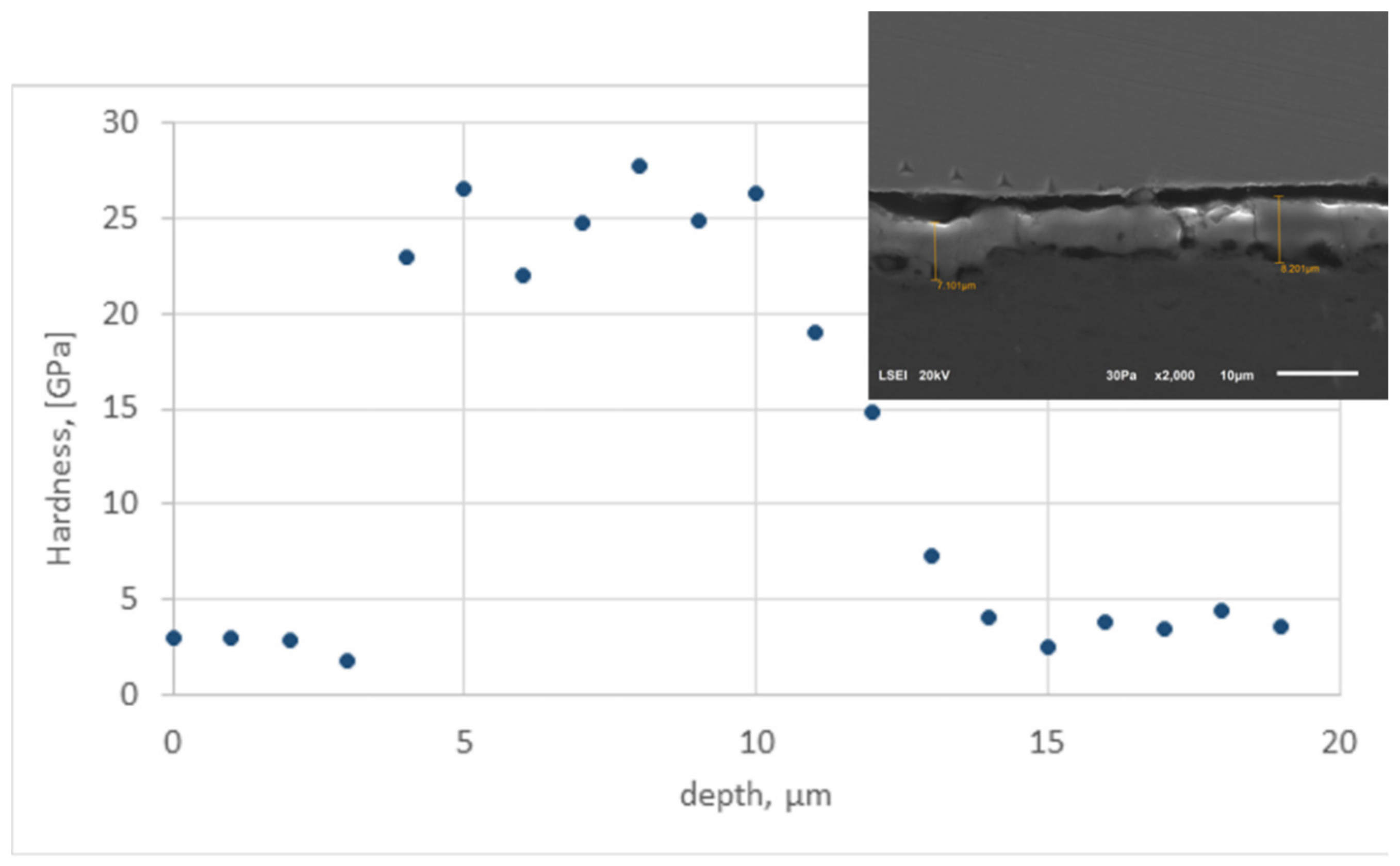
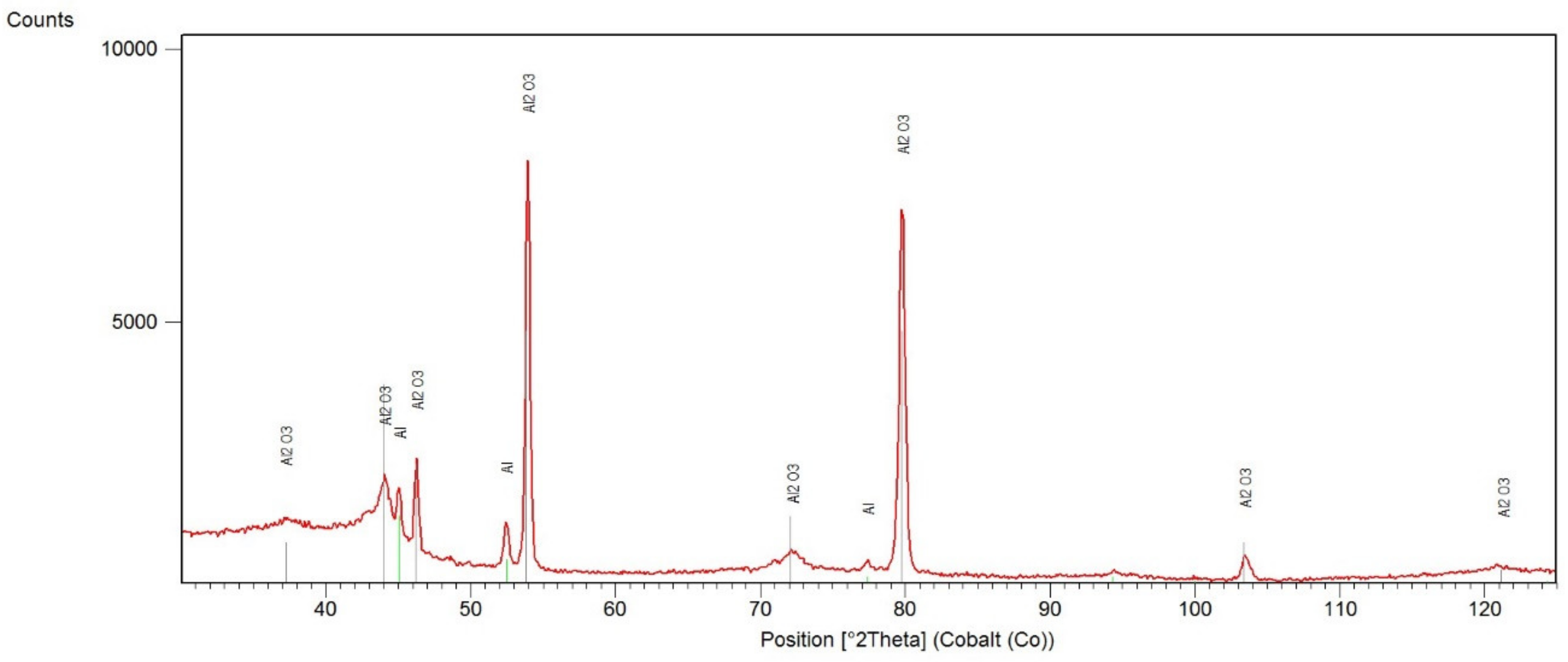


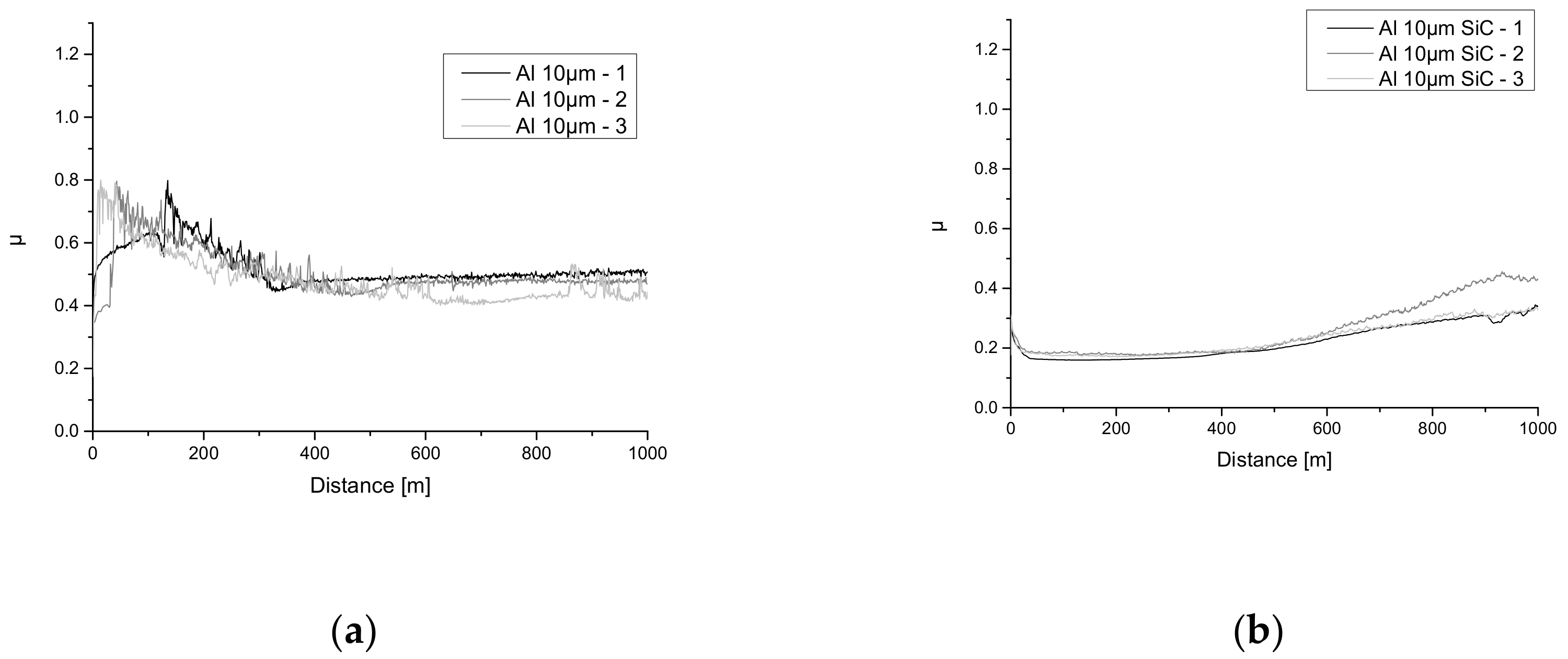
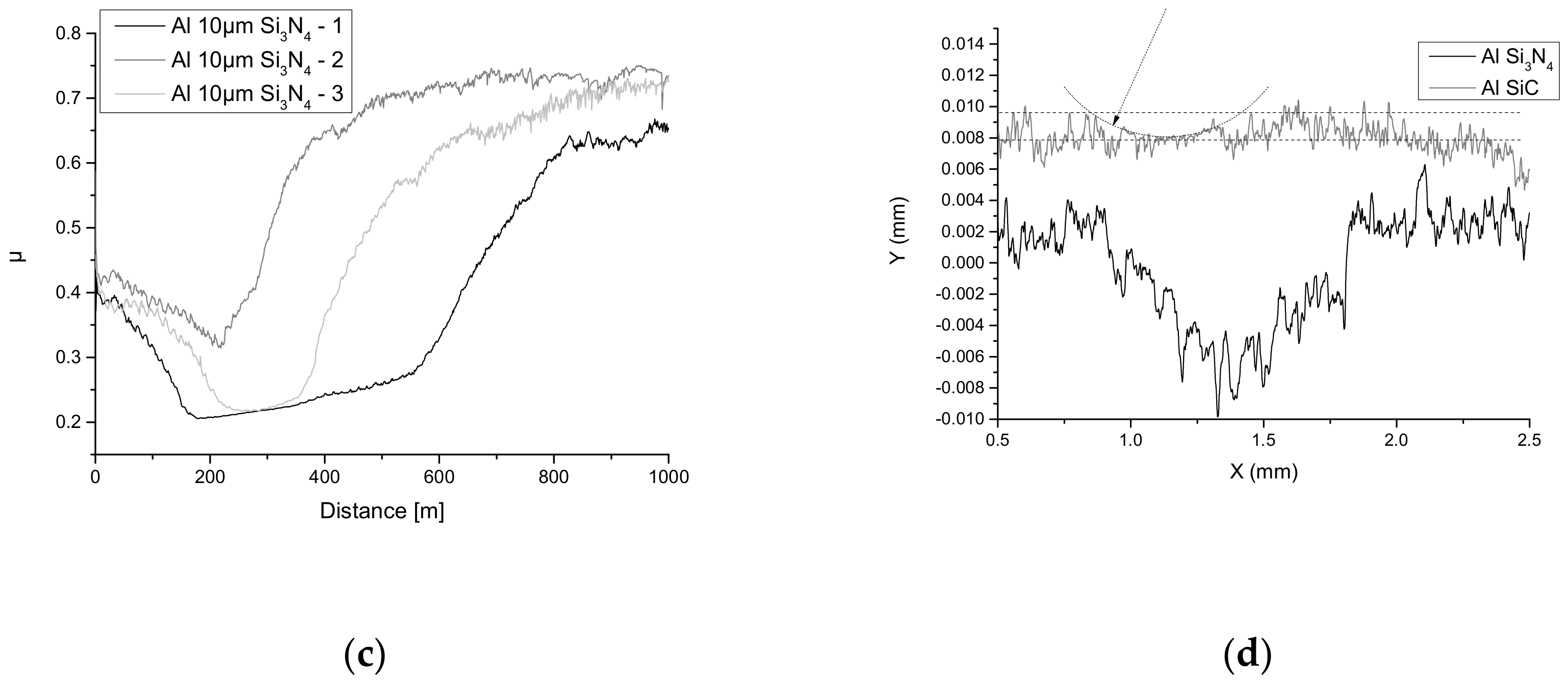
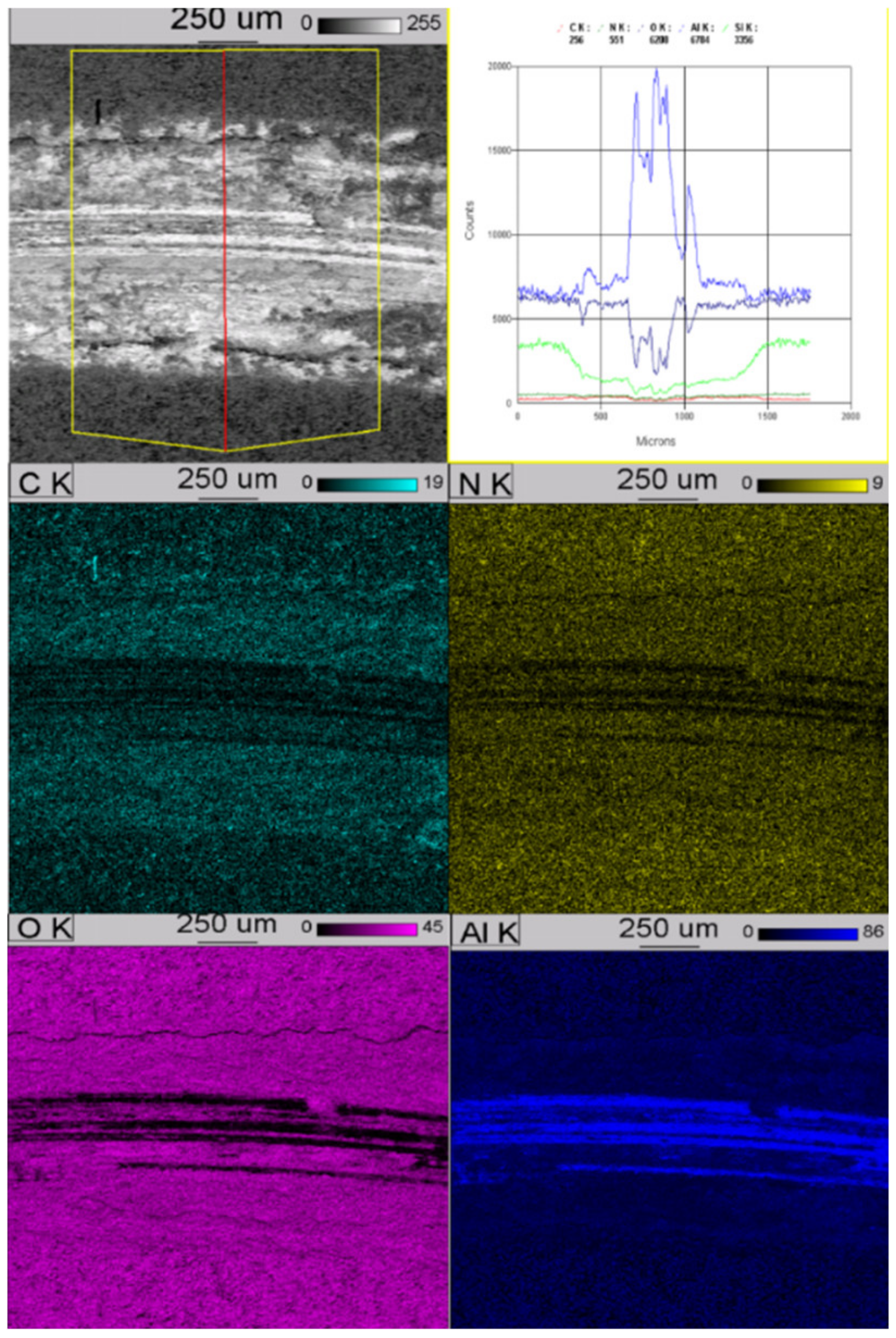
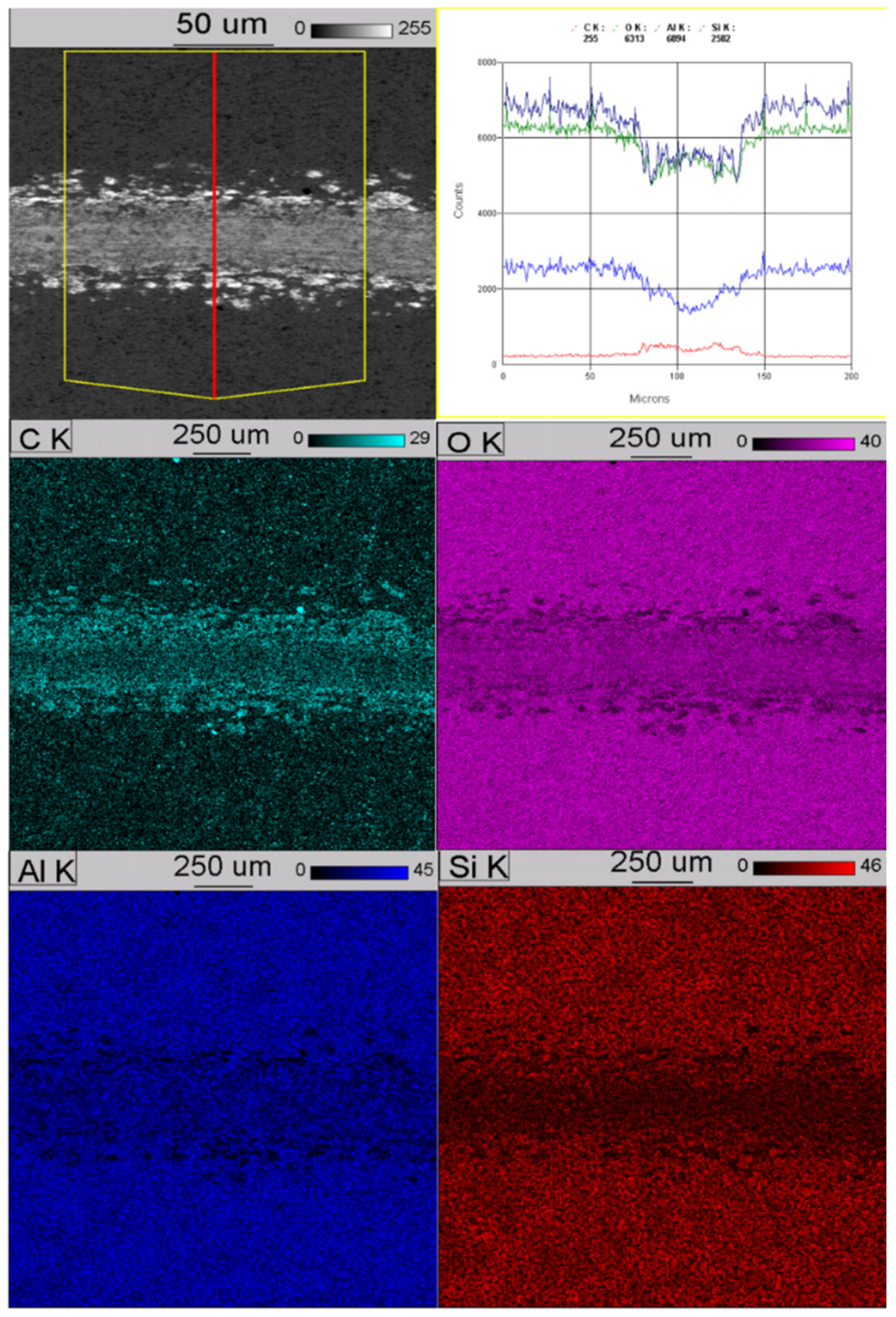
| Si | Fe | Cu | Mn | Mg | Cr | Zn | Ti | Other | Al | |
|---|---|---|---|---|---|---|---|---|---|---|
| wt.(%) | 0.2–0.8 | 0.7 max | 3.5–4.5 | 0.4–1 | 0.4–0.8 | 0.1 max | 0.25 max | 0.15 max | 0.15 max | balance |
| Tensile strength | Yield strength | Young modulus | Hardness | Elongation | ||||||
| 379 MPa | 221 MPa | 72.4 GPa | 45 HB | 22% | ||||||
| Current Density(A/dcm2) | Voltage (V) | Inductance (H) | Electrolyte | Temperature (°C) |
|---|---|---|---|---|
| 6 | 500 | 1000 | Na2SiO3 + KOH | <10 |
| Specimen | Load (N)) | Subs. Temp. (°C) | Rel. Hum. RH (%) | Friction Radius (mm) | Friction Path(m) | Mean Value of Coef. Friction with Calculated SD | Wear Rate with Calculated SD (m3·N−1·m−1 × 10−15) |
|---|---|---|---|---|---|---|---|
| Al 10 µm–1 | 5 | 24 | 64 | 10 | 1000 | 0.48 ± 0.08 | 2 ± 0.6 |
| Al 10 µm–2 | 5 | 24 | 64 | 0.51 ± 0.08 | 2.5 ± 0.3 | ||
| Al 10 µm–3 | 10 | 27.7 | 63 | 0.52 ± 0.06 | 4 ± 2 | ||
| Al 10 µm SiC–1 | 4 | 26 | 49 | 0.22 ± 0.06 | 1.4 ± 0.6 | ||
| Al 10 µm SiC–2 | 5 | 21.7 | 60 | 0.26 ± 0.09 | 1.9 ± 0.1 | ||
| Al 10 µm SiC–3 | 5 | 25.8 | 59.8 | 0.23 ± 0.05 | 2.5 ± 0.9 | ||
| Al 10 µm Si3N4–1 | 4 | 21.5 | 53.4 | 0.4 ± 0.2 | 15 ± 3 | ||
| Al 10 µm Si3N4–2 | 5 | 25.5 | 50.8 | 0.6 ± 0.2 | 20 ± 3 | ||
| Al 10 µm Si3N4–3 | 5 | 26.3 | 48 | 0.5 ± 0.2 | 94 ± 4 |
© 2020 by the authors. Licensee MDPI, Basel, Switzerland. This article is an open access article distributed under the terms and conditions of the Creative Commons Attribution (CC BY) license (http://creativecommons.org/licenses/by/4.0/).
Share and Cite
Atraszkiewicz, R.; Makówka, M.; Kołodziejczyk, Ł.; Januszewicz, B.; Sucharkiewicz, J. Frictional Behaviour of Composite Anodized Layers on Aluminium Alloys. Materials 2020, 13, 3747. https://doi.org/10.3390/ma13173747
Atraszkiewicz R, Makówka M, Kołodziejczyk Ł, Januszewicz B, Sucharkiewicz J. Frictional Behaviour of Composite Anodized Layers on Aluminium Alloys. Materials. 2020; 13(17):3747. https://doi.org/10.3390/ma13173747
Chicago/Turabian StyleAtraszkiewicz, Radomir, Marcin Makówka, Łukasz Kołodziejczyk, Bartłomiej Januszewicz, and Jan Sucharkiewicz. 2020. "Frictional Behaviour of Composite Anodized Layers on Aluminium Alloys" Materials 13, no. 17: 3747. https://doi.org/10.3390/ma13173747
APA StyleAtraszkiewicz, R., Makówka, M., Kołodziejczyk, Ł., Januszewicz, B., & Sucharkiewicz, J. (2020). Frictional Behaviour of Composite Anodized Layers on Aluminium Alloys. Materials, 13(17), 3747. https://doi.org/10.3390/ma13173747






